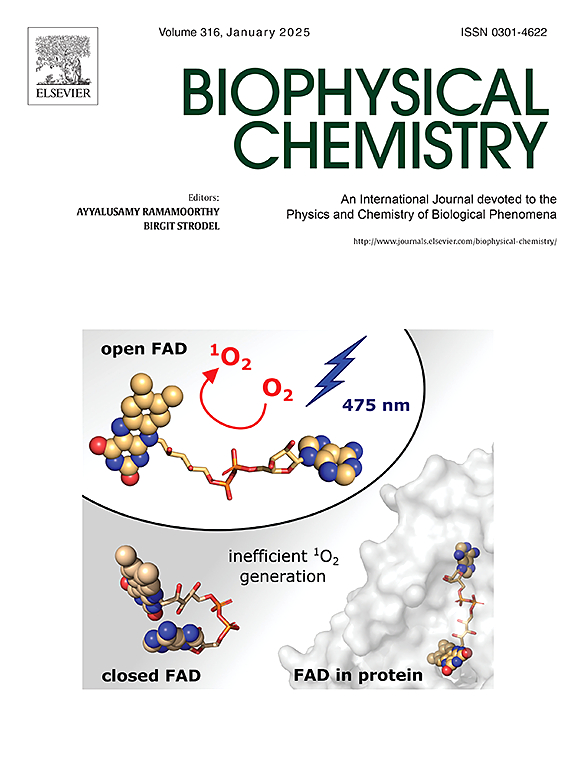Interaction of Myrsinoic acid a with biomembrane models: Differential effects on DPPC and DPPS properties revealed by surface rheology and vibrational spectroscopy
IF 2.2
3区 生物学
Q2 BIOCHEMISTRY & MOLECULAR BIOLOGY
引用次数: 0
Abstract
This study investigates the interactions of Myrsinoic acid A, a natural compound with reported anti-inflammatory and antitumor properties, with lipid monolayers composed of dipalmitoylphosphatidylcholine (DPPC) and dipalmitoylphosphatidylserine (DPPS). Utilizing tensiometry, polarization-modulation infrared reflection-absorption spectroscopy (PM-IRRAS), Brewster Angle Microscopy (BAM), and surface rheology, we analyzed how Myrsinoic acid A affects the structural and mechanical properties of these lipid systems. The PM-IRRAS spectra revealed that Myrsinoic acid A induced disorder in the DPPC monolayer, shifting CH₂ asymmetric stretching peaks and decreasing packing order, while DPPS remained structurally stable. Surface rheology measurements showed reduced elasticity in both lipids, with differential effects on viscosity: a decrease for DPPC and an increase for DPPS, indicating varied molecular interactions. BAM images confirmed that DPPC maintained a homogeneous morphology, while DPPS displayed aggregate formation, suggesting distinct lipid-drug interactions. These findings highlight the importance of lipid composition in modulating the effects of Myrsinoic acid A on membrane properties, providing insights into its potential therapeutic applications in targeting tumorigenic versus non-tumorigenic cells.

蜜桃酸a与生物膜模型的相互作用:通过表面流变学和振动光谱揭示对DPPC和DPPS性能的差异影响
本研究研究了具有抗炎和抗肿瘤特性的天然化合物桃金酸A与双棕榈酰磷脂酰胆碱(DPPC)和双棕榈酰磷脂酰丝氨酸(DPPS)组成的脂质单分子膜的相互作用。利用张力测定法、偏振调制红外反射吸收光谱(PM-IRRAS)、Brewster角度显微镜(BAM)和表面流变学,我们分析了桃金酸A如何影响这些脂质系统的结构和力学性能。PM-IRRAS光谱显示,桃金酸A导致DPPC单层结构紊乱,ch2不对称拉伸峰移位,堆积顺序降低,而DPPS结构保持稳定。表面流变学测量表明,两种脂类的弹性都降低了,对粘度的影响不同:DPPC降低,DPPS增加,表明不同的分子相互作用。BAM图像证实DPPC保持均匀形态,而DPPS显示聚集形成,表明明显的脂质-药物相互作用。这些发现强调了脂质组成在调节桃金酸A对膜特性的影响中的重要性,为其针对致瘤细胞和非致瘤细胞的潜在治疗应用提供了见解。
本文章由计算机程序翻译,如有差异,请以英文原文为准。
求助全文
约1分钟内获得全文
求助全文
来源期刊

Biophysical chemistry
生物-生化与分子生物学
CiteScore
6.10
自引率
10.50%
发文量
121
审稿时长
20 days
期刊介绍:
Biophysical Chemistry publishes original work and reviews in the areas of chemistry and physics directly impacting biological phenomena. Quantitative analysis of the properties of biological macromolecules, biologically active molecules, macromolecular assemblies and cell components in terms of kinetics, thermodynamics, spatio-temporal organization, NMR and X-ray structural biology, as well as single-molecule detection represent a major focus of the journal. Theoretical and computational treatments of biomacromolecular systems, macromolecular interactions, regulatory control and systems biology are also of interest to the journal.
 求助内容:
求助内容: 应助结果提醒方式:
应助结果提醒方式:


